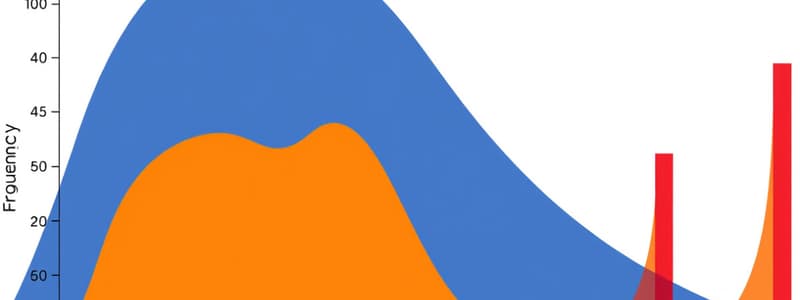Podcast
Questions and Answers
What are descriptive statistics?
What are descriptive statistics?
To simplify the organization and presentation of data.
What is a frequency distribution?
What is a frequency distribution?
An organized tabulation of the number of individuals located in each category on the scale of measurement.
With an ordinal, interval, or ratio scale, the categories can be listed in any order.
With an ordinal, interval, or ratio scale, the categories can be listed in any order.
False (B)
The equation f = N is true.
The equation f = N is true.
The equation X = 5 + 4 + 4 + 3 + 3 + 3 + 2 + 2 + 2 + 1 is true.
The equation X = 5 + 4 + 4 + 3 + 3 + 3 + 2 + 2 + 2 + 1 is true.
What is the value of X2 = 5^2 + 4^2 + 4^2 + 3^2 + 3^2 + 3^2 + 2^2 + 2^2 + 2^2 + 1^2?
What is the value of X2 = 5^2 + 4^2 + 4^2 + 3^2 + 3^2 + 3^2 + 2^2 + 2^2 + 2^2 + 1^2?
What is a proportion in statistical terms?
What is a proportion in statistical terms?
How is percentage calculated in statistics?
How is percentage calculated in statistics?
Why is it unreasonable to list all individual scores in a frequency distribution table?
Why is it unreasonable to list all individual scores in a frequency distribution table?
Which of the following statements about multiples is correct?
Which of the following statements about multiples is correct?
What is the first step in constructing a frequency distribution table?
What is the first step in constructing a frequency distribution table?
What is a continuous variable?
What is a continuous variable?
Flashcards are hidden until you start studying
Study Notes
Descriptive Statistics
- Simplifies the organization and presentation of data.
Frequency Distribution
- Organized tabulation of the number of individuals in each measurement category.
- Arranges scores from highest to lowest, grouping individuals with the same score.
- Contains two components: measurement scale categories and frequency of individuals in each category.
Scale Categories
- Ordinal, interval, or ratio scales list categories in order, typically from highest to lowest.
- Nominal scales allow categories to be listed in any order.
Mathematical Relationships
- Formula f = N is true, indicating frequency equals the total number of individuals.
- X equals the summation of specific values, confirming the calculation is correct.
- Calculation of X² gives a total of 97 based on stated values.
Proportions and Percentages
- Proportion (relative frequencies) measures the fraction of the total group associated with each score (p = N/f).
- Percentage is calculated by N/f multiplied by 100.
Grouped Frequency Distribution Table
- Necessary for presenting large sets of scores efficiently (e.g., exam scores from 41 to 96).
- Utilizes class intervals rather than individual scores, aiming for roughly 10 intervals with simple widths (2, 5, 10, or 20).
- Each interval must be uniform in width, cover the score range completely, and ensure no overlap or gaps.
Constructing a Frequency Distribution Table
- First step: Identify the range of scores; smallest and largest determine needed rows.
- Choose a simple interval width aimed at creating around 10 intervals.
- Lowest score determines starting point for intervals, ensuring bottom scores are multiples of the interval width.
- Example: Starting at 50 for an interval width of 5 results in intervals like 50-54, 55-59.
Continuous Variables
- Possess infinite possible values and are represented on a continuous number line.
- Measurements correspond to intervals rather than fixed points; e.g., 8 seconds represents an interval from 7.5 to 8.5 seconds.
- Frequency distribution for continuous variables reflects individuals falling within measurement intervals rather than exact scores.
Studying That Suits You
Use AI to generate personalized quizzes and flashcards to suit your learning preferences.




